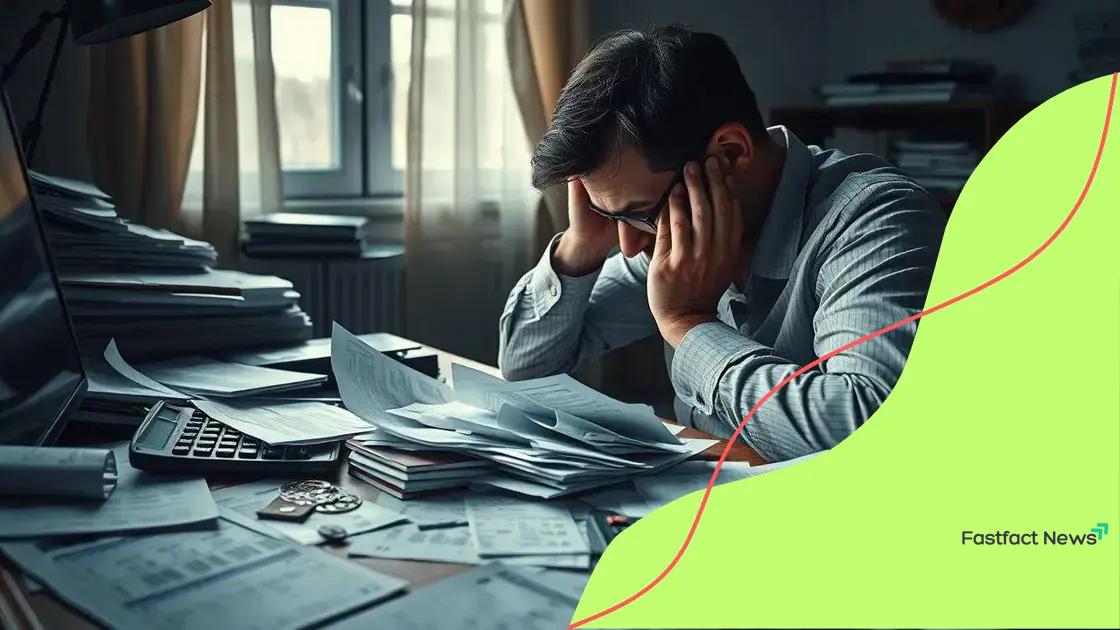Consumer debt reaches new high: what it means for you

Anúncios
Consumer debt reaches new highs, significantly impacting financial health through increased anxiety, payment struggles, and lower credit scores, necessitating proactive management strategies and seeking professional assistance when needed.
Consumer debt reaches new high levels, causing concern for many individuals and families. How does this impact your daily life and future financial stability? Let’s dive in.
Anúncios
Understanding the current state of consumer debt
Understanding the current state of consumer debt is essential for managing your finances effectively. Consumer debt has reached alarming levels, impacting households across the nation.
The rise in debt can be attributed to various factors. For many, credit cards are a primary source of financial flexibility. However, relying too much on credit can lead to overwhelming debt.
Key Factors Contributing to Rising Debt
Several elements influence the increase in consumer debt:
Anúncios
- Easy access to credit cards and loans
- Unexpected life events, like medical expenses
- Social pressures to maintain a certain lifestyle
- Inflation and rising living costs
Many consumers may also not fully understand their debt. This can contribute to a cycle of borrowing without a clear repayment plan. It is vital to recognize how much you owe and to whom.
Consumer Debt Statistics
Statistics reveal that millions are living with significant debt burdens. According to recent studies, many individuals have credit card balances that exceed their ability to pay them off:
- Over 40% of Americans carry credit card debt month to month.
- The average household with debt owes nearly $16,000.
- Student loan debt continues to rise, impacting young adults.
Not understanding these statistics could have serious implications. Better awareness helps in creating effective budgets and payment plans.
Ultimately, recognizing the current state of consumer debt empowers individuals. By staying informed and aware, you can take steps to mitigate your own financial risks and improve your overall financial health.
Factors contributing to rising consumer debt
Several factors contributing to rising consumer debt can significantly impact how individuals manage their finances. Understanding these elements can help consumers make informed decisions about their spending and saving habits.
One major factor is the easy access to credit. Many consumers have multiple credit cards and loans, making borrowing convenient. However, this convenience often leads to overspending, as people may not feel the immediate impact of their purchases.
Economic Pressures
Economic conditions play a vital role as well. When inflation rises or there is economic uncertainty, many individuals find themselves relying on debt to cover basic expenses. This ongoing reliance can create a slippery slope into deeper debt.
- Increased cost of living impacts disposable income.
- Wage growth may not keep pace with inflation.
- Job instability can lead to urgent financial decisions.
Another significant factor is life events that can lead to unexpected expenses. For example, medical emergencies, job loss, or significant life changes can strain financial resources. When faced with these situations, many people turn to credit as a lifeline, further increasing their debt.
Societal Influence
The influence of societal norms cannot be underestimated. Social media often highlights lifestyles that encourage spending beyond one’s means. The pressure to keep up with peers can lead individuals to accumulate debt to maintain a certain image or status, often resulting in long-term financial strain.
Lastly, a lack of financial education contributes to misunderstandings about credit and debt management. Many consumers do not fully grasp the terms of their debt, which can lead to poor financial decisions. Without the right knowledge, managing debt becomes increasingly difficult, making recovery from high debt more challenging.
Impacts of high debt on personal finances

The impacts of high debt on personal finances can be profound and far-reaching. Many individuals may not realize how much their financial health is affected until it’s too late. High debt levels can lead to stress and affect many areas of life.
One immediate effect of high debt is the drain on monthly budgets. When a significant portion of income goes toward servicing debt, there is less available for essential expenses. Basic needs often become a challenge to manage as debt repayments take priority.
Credit Score Consequences
Moreover, high debt can heavily influence an individual’s credit score. A lower credit score can lead to higher interest rates on loans, making future borrowing more expensive. This can create a cycle where debts become harder to manage over time.
- Late payments harm credit history.
- Utilization rate of credit impacts score.
- Difficulty obtaining new credit increases.
As debt levels rise, individuals may also experience heightened stress and anxiety. Money-related stress can affect personal relationships and mental health. The constant worry about financial obligations can lead to tension in households and diminish overall quality of life.
Long-Term Financial Consequences
In the long term, high debt levels can derail financial goals. Saving for retirement or emergencies may become nearly impossible. Individuals may find themselves living paycheck to paycheck, with little to no savings to fall back on during tough times.
Additionally, high debt can limit career choices. People may feel compelled to stay in jobs they dislike just to make ends meet. This can lead to dissatisfaction and burnout, further complicating financial well-being.
Being aware of the impacts of high debt is crucial. Understanding these consequences allows individuals to take proactive steps to manage their debt and improve their financial stability.
Strategies to manage and reduce debt
Implementing effective strategies to manage and reduce debt is crucial for financial well-being. Many individuals face challenges with debt, but there are practical approaches that can help regain control of finances.
One effective method is to create a budget that tracks all income and expenses. This detailed picture allows individuals to see where their money goes and identifies areas where they can cut back. For many, reallocating funds from non-essential purchases can free up money to pay down debt.
Debt Snowball Method
One popular debt repayment strategy is the debt snowball method. Here’s how it works:
- List all debts from smallest to largest.
- Make minimum payments on all debts except the smallest.
- Put any extra money toward the smallest debt until it’s paid off.
- Move to the next smallest debt and repeat the process.
This approach helps build momentum and motivates individuals as they pay off smaller debts quickly, creating a sense of achievement.
Negotiate with Creditors
Another strategy involves negotiating with creditors. Many lenders are willing to work with individuals struggling to make payments. Some options include:
- Requesting lower interest rates.
- Asking for a payment plan or settlement.
- Looking into debt consolidation options.
Negotiating can greatly reduce financial stress and make payments more manageable. Additionally, seeking professional advice from a financial counselor can provide personalized strategies tailored to unique financial situations.
Staying disciplined is vital when implementing these strategies. Regularly reviewing and adjusting budgets ensures that financial goals stay on track. Keeping a positive mindset and celebrating small victories along the way helps maintain motivation on the path to financial freedom.
Spotting signs of debt distress and seeking help
Spotting signs of debt distress early can prevent financial situations from worsening. It is important to recognize these signs to seek help before debt becomes unmanageable. Many people may not realize they are in trouble until stress begins to affect their everyday lives.
One key sign of debt distress is missing payments. If you find yourself unable to make payments on time, it often signals that your financial situation is deteriorating. Late fees can add to the problem, making it harder to catch up. Similarly, if debt collectors are calling frequently, it indicates that creditors are concerned about your ability to pay.
Behavioral Signs
Another indication can be changes in spending habits. Overspending on non-essentials or relying more on credit cards for basic needs suggests growing financial trouble. Stress related to payments can also lead to anxiety, affecting both physical and mental health.
- Noticeable changes in mood or increased anxiety about finances.
- Withdrawing from social activities due to financial concerns.
- Feeling overwhelmed by the amount of debt you have.
Seeking help requires an understanding of the available resources. Professional advice can provide clarity and guidance for tackling debt problems. Financial counselors can work with you to develop a budget and repayment plan tailored to your needs.
Where to Seek Help
Several organizations offer support and advice to those facing debt distress. These include:
- Non-profit credit counseling agencies that can assist with debt management plans.
- Financial advisors who specialize in debt reduction strategies.
- Online resources providing tools for budgeting and financial literacy.
By recognizing the signs of debt distress and seeking help early, individuals can take proactive steps toward regaining control of their finances. Remember, reaching out for assistance is a strong and positive action.
FAQ – Common Questions About Managing Consumer Debt
What should I do if I can’t make my debt payments?
If you can’t make your debt payments, contact your creditors to discuss your situation. They may offer options such as a payment plan or lower interest rates.
How can I improve my credit score while in debt?
To improve your credit score while in debt, make sure to pay your bills on time and keep your credit utilization low by not maxing out your credit cards.
What is the debt snowball method?
The debt snowball method involves listing your debts from smallest to largest and focusing on paying off the smallest first, which helps build momentum as you eliminate debts.
When should I seek professional help for debt management?
You should seek professional help for debt management as soon as you notice signs of distress, such as missed payments or increasing stress about your financial situation.
